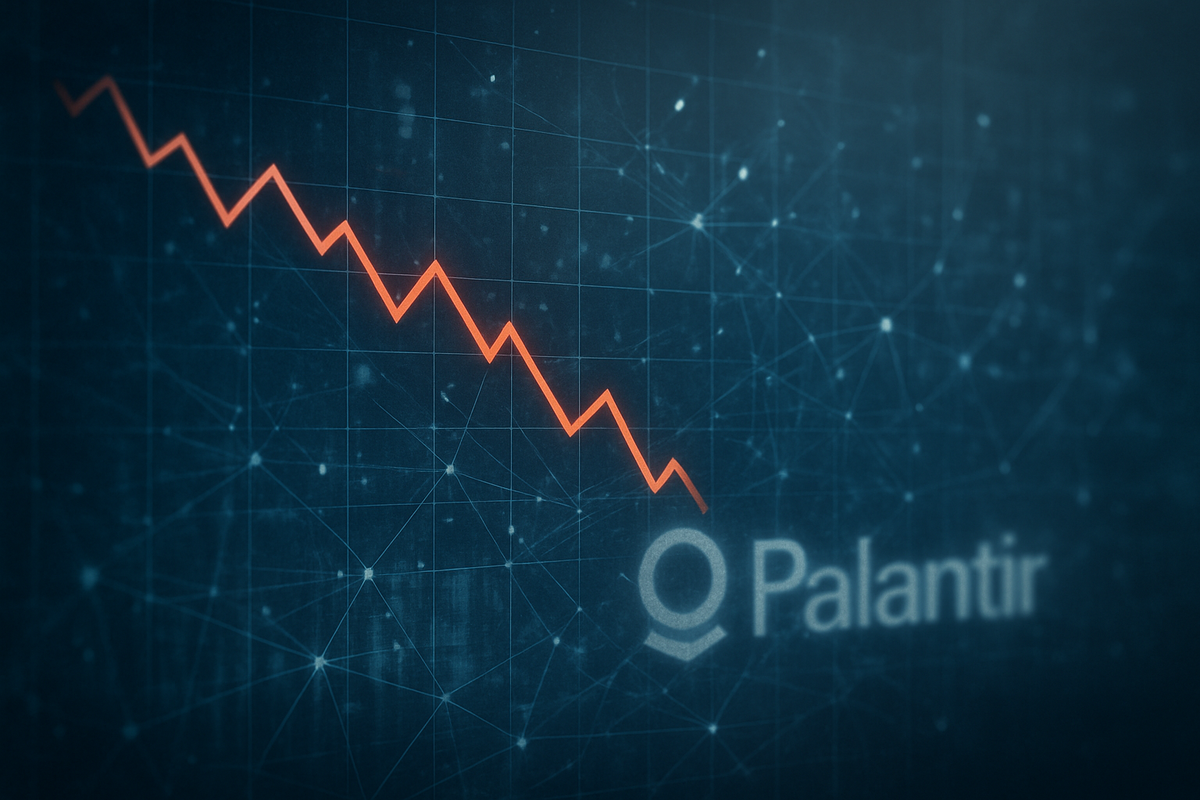
Palantir Technologies (NYSE: PLTR), a prominent player in the data analytics and artificial intelligence space, has experienced a significant stock market tumble in early to mid-November 2025. This sharp correction, which saw shares fall by over 5% on November 13th alone and nearly 14.5% in the first week of November, has rattled investors who had previously seen the stock soar by over 150% year-to-date. The immediate implications point to a confluence of factors, including aggressive profit-taking after a sustained rally, growing concerns over the company's "stretched" valuation, and a broader "sell the news" reaction following strong Q3 2025 earnings.
The downturn reflects a growing skepticism in the market regarding the sustainability of high valuations for certain AI and tech stocks, with Palantir's rich price-to-earnings ratios becoming a focal point for bearish sentiment. This event not only marks a crucial moment for Palantir but also signals potential shifts in investor appetite for high-growth, high-valuation technology companies, prompting a re-evaluation of market fundamentals in the broader tech landscape.
Palantir's Precipitous Drop: A Closer Look at the November 2025 Sell-Off
Palantir Technologies' stock has been on a rollercoaster ride in November 2025, culminating in a notable decline that has wiped out a significant portion of its earlier gains. On November 13th, the stock traded around $174.16, marking a 5.44% drop for the day. This followed a nearly 5% decrease around November 12th and an 8.1% decline on November 4th, which was the largest single-day drop since August 2025. The first week of November alone saw PLTR shed approximately 14.5% of its value, extending a trend that included a six-day losing streak in August 2025, its longest since April 2024, which saw the stock fall almost 20% from its then all-time high.
This recent sell-off comes despite Palantir reporting robust Q3 2025 earnings. The company announced a substantial 63% year-over-year revenue jump, reaching $1.181 billion, alongside strong adjusted operating income and an upward revision of its full-year guidance. However, these positive fundamentals were met with a "sell the news" reaction, suggesting that investors had already priced in the expected strong performance and used the earnings release as an opportunity to lock in profits. The core issue driving the decline appears to be widespread apprehension about Palantir's "rich" valuation, with P/E ratios reportedly hovering around 407-434, leading many analysts to deem the stock significantly overvalued.
Key players contributing to the increased bearish sentiment include prominent investors like Michael Burry, known for "The Big Short," who disclosed a short position against Palantir by holding put options on 5 million shares, significantly "rattling sentiment." Citron Research also weighed in, projecting further downside for the stock. This localized Palantir correction also occurred amidst a broader pullback in the technology and artificial intelligence sectors, with other AI-related companies like Nvidia (NASDAQ: NVDA) and Advanced Micro Devices (NASDAQ: AMD) also experiencing declines, hinting at wider market concerns about a potential "AI bubble." Despite its strong fundamentals, including surging U.S. commercial sector growth (up 121% in Q3 2025) and expanding profitability, the market's focus has shifted to the perceived unsustainability of its current valuation.
The Ripple Effect: Winners and Losers in the Wake of Palantir's Dip
Palantir's (NYSE: PLTR) recent stock market tumble is likely to send ripples through the competitive landscape of data analytics and artificial intelligence, potentially creating both winners and losers among its peers and partners. While a direct correlation is complex, a significant correction in a market leader like Palantir can shift investor sentiment and capital flows.
Companies that could potentially "win" from Palantir's struggles are its direct competitors in the enterprise data analytics and government intelligence sectors. Firms offering alternative AI-powered data platforms, such as C3.ai (NYSE: AI), Alteryx (NYSE: AYX), and even larger enterprise software providers like Microsoft (NASDAQ: MSFT) with its Azure AI services, could see increased investor interest if Palantir's valuation concerns persist. Investors might rotate out of what they perceive as an overvalued PLTR into competitors with more "reasonable" valuations or clearer growth trajectories. Similarly, specialized defense contractors or government IT solution providers that also dabble in data integration and AI, like Leidos (NYSE: LDOS) or Booz Allen Hamilton (NYSE: BAH), might be viewed more favorably if government clients diversify their reliance away from a single dominant provider, or if the market seeks more established, less volatile players in the government tech space.
Conversely, companies heavily reliant on partnerships with Palantir or those whose business models are closely tied to the broader sentiment surrounding the "AI boom" could face headwinds. While Palantir's own commercial growth has been robust, any slowdown in its expansion due to market pressures could indirectly affect smaller tech firms that integrate with Palantir's platforms or provide complementary services. Furthermore, the increased bearish sentiment towards high-valuation AI stocks could broadly impact the funding and valuation of other AI startups and privately held companies seeking future public offerings. The Palantir correction might serve as a cautionary tale, prompting a more scrutinizing look at profitability and sustainable growth models across the entire AI ecosystem, potentially making it harder for early-stage AI companies to attract capital at previous high valuations.
The event also highlights the ongoing challenge for investors to differentiate between genuine technological innovation and speculative valuation in the rapidly evolving AI sector. Companies that can demonstrate clear, tangible returns on AI investments and sustainable growth without relying solely on future potential might gain an advantage, while those perceived as being part of an "AI bubble" could face similar pressures to Palantir.
Broader Implications: Navigating the AI Landscape and Market Sentiment
Palantir's (NYSE: PLTR) recent stock market correction is more than just a company-specific event; it serves as a crucial indicator of broader trends and shifts in the technology and financial markets, particularly within the burgeoning artificial intelligence sector. This downturn fits into a larger narrative of market recalibration, where investors are increasingly scrutinizing the valuations of high-growth tech companies, especially those that have seen exponential gains. It echoes warnings from some analysts about a potential "AI bubble," suggesting that while the underlying technology is transformative, market enthusiasm may have outpaced fundamental justification for some valuations.
The event could have ripple effects across the entire AI industry. Competitors and partners will likely observe investor reactions closely. For competitors, a perceived weakness in a market leader could present an opportunity to gain market share or attract investment. For partners, particularly smaller firms that integrate with Palantir's platforms, any long-term impact on Palantir's growth trajectory or strategic focus could necessitate adjustments to their own business plans. Moreover, the increased scrutiny on valuation might lead to a more conservative approach from venture capitalists and private equity firms when funding AI startups, potentially impacting the pace of innovation and market entry for new players.
From a regulatory and policy perspective, Palantir's reliance on government contracts (still nearly 55% in 2024 and 52% in Q3 2025) highlights the critical interplay between national security, data privacy, and technological advancement. A significant market event for a company deeply embedded in government infrastructure could draw further attention to issues of data sovereignty, ethical AI deployment, and the concentration of power among a few dominant tech providers. While there are no immediate regulatory changes directly linked to Palantir's stock performance, sustained volatility or concerns about its market practices could indirectly fuel calls for greater oversight in the AI and data analytics sectors, particularly concerning government contracts.
Historically, the tech market has seen similar cycles of rapid growth followed by sharp corrections, notably during the dot-com bubble burst of the early 2000s or more recent adjustments in specific tech sub-sectors. While the current situation is distinct, the underlying pattern of investor exuberance leading to stretched valuations, followed by a reality check, is a recurring theme. The "sell the news" phenomenon, observed even after Palantir's strong earnings, is a classic market behavior, indicating that expectations had run far ahead of even impressive performance. This historical context suggests that the current correction might be a healthy, albeit painful, process of market maturation for the AI sector, forcing a re-evaluation of what constitutes sustainable growth and value.
What Comes Next: Navigating Palantir's Future and the Evolving AI Market
The coming months will be critical for Palantir (NYSE: PLTR) as it navigates the aftermath of its recent stock market tumble and seeks to re-establish investor confidence. In the short term, the company will likely face continued pressure from bearish sentiment and valuation concerns. Investors will be closely watching for any signs of sustained growth, particularly in its U.S. commercial sector, which has been a significant driver of recent success. Any slowdown in this area, or increased competition, could exacerbate current challenges. Palantir may need to communicate more clearly its long-term strategy for profitability and market expansion, perhaps focusing on specific growth verticals beyond its traditional government contracts.
In the long term, Palantir's success will hinge on its ability to leverage its cutting-edge AI platforms, Foundry and Gotham, to expand its commercial footprint globally and diversify its revenue streams. The company's continued investment in AI research and development, particularly in areas like large language models and advanced analytics, will be crucial. Potential strategic pivots could include more aggressive partnerships with cloud providers or industry-specific solution integrators to broaden its reach. Furthermore, Palantir might explore acquisitions of smaller, specialized AI firms to enhance its technological capabilities or enter new markets.
Market opportunities for Palantir could emerge from the increasing global demand for data-driven decision-making across industries, from healthcare to manufacturing. As more organizations seek to harness the power of AI to optimize operations and gain competitive advantages, Palantir's platforms could find new applications. However, challenges include intense competition from both established tech giants and nimble startups, the ongoing debate around AI ethics and regulation, and the need to continually demonstrate clear return on investment for its sophisticated and often expensive solutions. The company's ability to simplify its offerings and make them more accessible to a wider range of enterprises could be a key to unlocking future growth.
Potential scenarios range from a gradual recovery, as Palantir demonstrates consistent execution and more sustainable growth, to further volatility if broader market conditions for tech stocks deteriorate or if the company fails to address valuation concerns effectively. Another scenario involves Palantir becoming an attractive acquisition target for a larger tech conglomerate seeking to bolster its AI capabilities, though its unique business model and government ties could complicate such a move. The outcome will largely depend on Palantir's strategic adaptations, its ability to communicate its value proposition more effectively to the market, and the overall health of the global economy and technology sector.
Comprehensive Wrap-Up: Key Takeaways and the Path Forward for Investors
Palantir's (NYSE: PLTR) recent stock market tumble serves as a potent reminder of the inherent volatility and speculative nature that can accompany high-growth technology stocks, particularly those at the forefront of transformative fields like artificial intelligence. The key takeaway from this event is the critical importance of distinguishing between groundbreaking technology and sustainable valuation. While Palantir's robust Q3 2025 earnings and impressive year-to-date performance underscore its strong fundamentals and leadership in AI, the market's reaction highlights that even stellar growth can be overshadowed by concerns of an "overheated" valuation. The "sell the news" phenomenon and the influence of prominent bearish investors like Michael Burry underscore the psychological and technical factors that often drive market movements, even in the face of positive corporate news.
Moving forward, the market will likely adopt a more discerning eye towards AI companies. Investors will be seeking not just growth, but profitable, sustainable growth, with clearer paths to cash flow and more reasonable valuation multiples. For Palantir, this means a renewed focus on demonstrating the tangible value proposition of its platforms to a wider commercial audience, reducing its historical reliance on government contracts, and potentially engaging in more aggressive investor relations to demystify its complex offerings. The broader tech sector may also experience a period of recalibration, with capital potentially flowing into companies with stronger balance sheets, clearer profitability, or more conservative valuations.
Final thoughts on the significance and lasting impact of this event point to a maturing AI market. While the long-term potential of AI remains undisputed, the recent correction suggests that the "easy money" phase for some high-flying AI stocks may be drawing to a close. This could usher in a more disciplined investment environment where fundamentals, profitability, and clear competitive advantages take precedence over pure growth narratives. Investors should watch for Palantir's upcoming earnings reports for signs of continued commercial expansion and margin improvements. They should also monitor broader market sentiment towards AI, regulatory developments concerning data analytics and government contracts, and the performance of Palantir's key competitors. The next few quarters will provide crucial insights into whether this tumble was a temporary setback or a harbinger of a more fundamental shift in how the market values Palantir and the AI industry as a whole.
This content is intended for informational purposes only and is not financial advice







